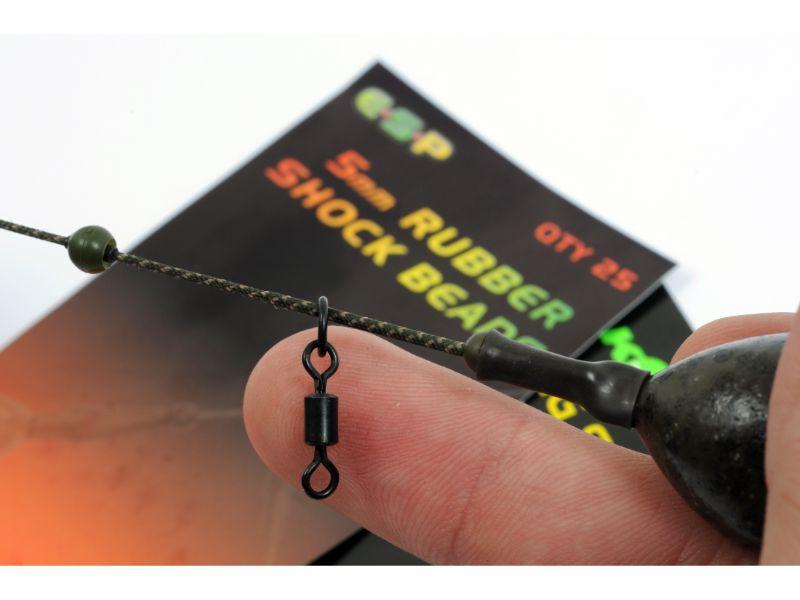How to tie a helicopter rig? Helicopter rigs are relatively simple to construct and ideal for when fishing over bottom debris. With few components you’re unlikely to need to go and buy loads of bits and pieces. Essentials though are size 8 ring swivels, buffer beads and some form of stop or bead to fit on the leader, above the hook link. This is the only area where it can get tricky as this component will be different according to your choice of leader or tubing.
What leaders/tubing can we use?
Anything is fine really. Tubing is maybe a bit less desirable but, with the right bead, still okay. Leadcore, lead-free, fused leaders or even naked is fine making the set-up very versatile indeed and applicable to a variety of waters and their rules.

Why is this top bead so important?
In a word: safety. The safety element of the set-up relies entirely on the way this bead works. Set-up correctly the helicoper rig is the safest rig around as, in the event of a breakage, the fish is left with no more than a hooklink. However, if that bead is not working as intended, the lead is prevented from jettisoning – a recipe for disaster.

What bead should be used then?
Well, that all depends on your choice of material. The bead has to provide a snug enough fit to prevent movement during the cast, however it should release and pop over any leader knot easily, allowing the hooklink to slide up and off the leader until it is free. Different brands, materials and diameters mean that one bead will not do it all and it might be necessary to try a few to achieve the perfect balance for the range of materials you use.
Beads for leadcore/lead-free: Not that long ago this was achieved by mounting a wide bore, tapered bead onto a short length of silicon tube, threaded onto the leader. Whilst this gave an effective release it was prone to slippage. These days there are several purpose designed options from various manufacturers. They range from ingenious oval beads with a “Y” shaped bore to slip over leader knots to ones that drop off the line completely when put under pressure.
Beads for fused leaders: Similar to above there are beads which sit snugly on fused, fluorocarbon leaders but ease along them under tension.
Beads for naked: Traditionally a wide bore tapered bead combined with a float stop or power gum stop knot was used although now, thanks to the popularity of naked chods, there are plenty of purpose made ones available.
Beads for tubing: In this instance the tapered, wide bore bead is still king. You will have to do a bit of testing to make sure it moves and your tubing must be firmly attached to the buffer bead so it doesn’t slip up the main line.
Whichever bead and leader combo you try make sure you test it and be aware of any casting/snag leaders too. The top bead must be able to pass over any leader knot with ease.
Next thread on a size 8 ring swivel
Next up it’s a size 8 ring swivel. Again, in the interests of safety, it’s imperative to thread the RING on to the leader, not the swivel. The ring is much larger giving safer passage over any knot. This swivel is the one to which you’ll attach your hooklink. Our favourite way is via a large figure of eight loop to give a neat, quick change option although your normal knot, or even a quick change link will work. Try and keep this bit neat though as any elbows or bulk could encourage tangles.

Add a buffer bead to prevent the ring swivel from getting jammed in the lead swivel
The ring swivel could easily jam over the lead swivel so a buffer bead is the next thing. These come in a variety of lengths and are used to provide a little cushioning for the hooklink swivel as well as neatening the profile to stave off tangles. You’ll need a long one to cover any quick change clips if you want to use them.
 Many anglers cut the swivel off the lead but leaving it on and using a short buffer bead retains a pivot point, which stops the possibility of the leader looping up off the bottom in the event of the lead sticking, point down in the lake bed.
Many anglers cut the swivel off the lead but leaving it on and using a short buffer bead retains a pivot point, which stops the possibility of the leader looping up off the bottom in the event of the lead sticking, point down in the lake bed.
What lead works best with a helicopter rig?
That’s entirely up to you. Any pendant lead, of any size, in any shape will work just fine. Slide a small length of tubing over the lead clip to neaten it up and reduce the risk and the clip catching on anything.
Slide a small length of tubing over the lead clip to neaten it up and reduce the risk and the clip catching on anything.
Attach your hooklink
Tie or loop to loop your chosen hooklink to the swivel to complete the rig.
Any final comments?
That’s about it really apart from reiterating the importance of making sure the top bead pops off the leader. Position it to suit the lake bed and you can stop worrying about presentation and concentrate on the other aspects. If you’re searching for a set up specifically to use over bottom debris then the helicopter rig is the one. Equally if you’d like something versatile, that’ll get you a bite in almost any situation, then stop looking – you’ve found it.